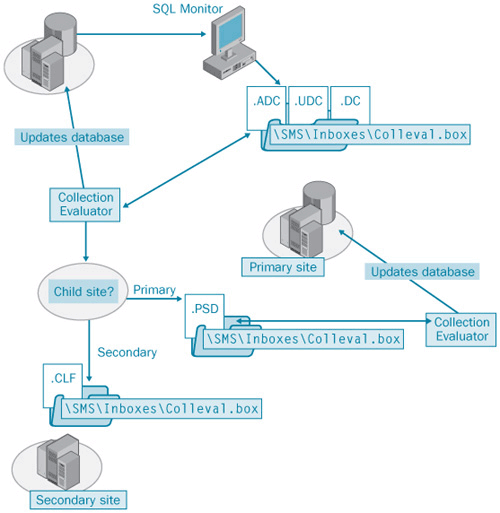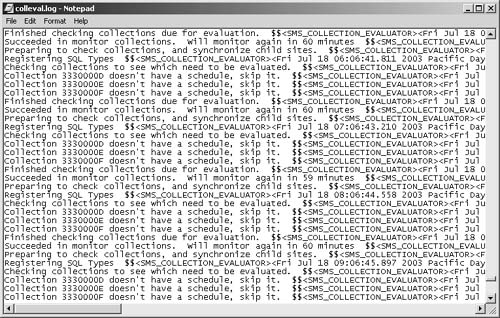3. Collection Evaluator Update Process Flow
Collection
Evaluator assigns resources to collections according to the most recent
data about the resources. Collection Evaluator waits for a file change
notification from SQL Monitor before the update process starts. As
shown in Figure 11,
SQL Monitor writes a wake-up file to Collection Evaluator’s inbox
(SMS\Inboxes\Colleval.box). SQL Monitor writes an update collection
(.UDC) file when the update is forced or a collection is modified, an
add collection (.ADC) file when a new collection is created, and a
delete collection (.DC) file when a collection is deleted. SQL Monitor,
like so many other components in SMS 2003, is driven by SQL trigger
events that cause the component ultimately to wake up and perform its
task. Collection Evaluator then executes the query and updates the
membership results in the SMS database.

If
the SMS site has child sites, Collection Evaluator also creates a .PSD
file that contains the collection definition and membership. It writes
this file to Replication Manager’s inbox (SMS\Inboxes\Replmgr.box) so
that the file can be scheduled and copied to Collection Evaluator’s
inbox on the child site. If the child site is a secondary site, the
file is rewritten to disk as a .CLF file and contains only the
collection memberships. If the child site is a primary site, the
collection will be processed in much the same fashion as described in
the beginning of this section.
When a
child site changes its parent site affiliation, Collection Evaluator is
responsible for removing any collections that the parent created (and
are therefore locked at the child site). When the child site joins the
new parent site, the collections created at the parent site are passed
down to the child site, and Collection Evaluator locks them and keeps
them updated.
4. Status Messages
As
with all SMS components, Collection Evaluator generates status messages
as it processes collections and subcollections, as well as a log file
if you’ve enabled logging for this component. The Status Message Viewer
window shown in Figure 12 displays typical status messages generated by Collection Evaluator. Notice that this component’s message IDs lie within the 25xx
range. For example, message ID 2516 indicates that Collection Evaluator
was notified that a new collection was added (by the SMS administrator,
of course). The .ADC file is a wake-up file written by SQL Monitor.

The
pairing of messages 2539 and 2510 indicates when the membership rules
for a collection were processed and when the collection was updated. A
2508 message indicates that Collection Evaluator is set to replicate
the site’s collections and subcollections to child sites.
In
addition to these status messages, Collection Evaluator writes its
thread activity to a log file named Colleval.log if you enabled logging
for this component. Figure 13you
can see, there’s really nothing remarkable here, except that you can
view on a per-thread basis when Collection Evaluator processes each
collection, updates or deletes wake-up files, and so on. displays log entries as viewed using Microsoft Notepad. As
